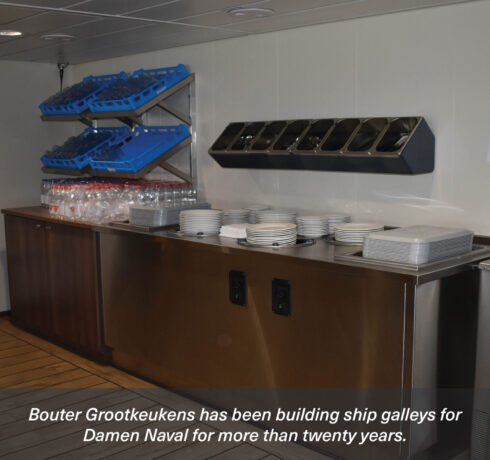Ships’ crews also have to eat. The kitchens on board the Combat Support Ship Den Helder and the icebreaker Nuyina are supplied by Bouter Grootkeukens. It is here where the food for the crews will soon be prepared. This renowned company has been building kitchens on Damen Naval vessels for years. You will find them on the four De Zeven Provinciën-class frigates (2002-2005), the amphibious transport ship HNLMS Johan de Witt (2007) and the logistics support ship HNLMS Karel Doorman (2015). “Building kitchens on a ship is a specialist skill,” say Bouter’s Project Manager René Wouters and Sales Manager Roland Moesman.
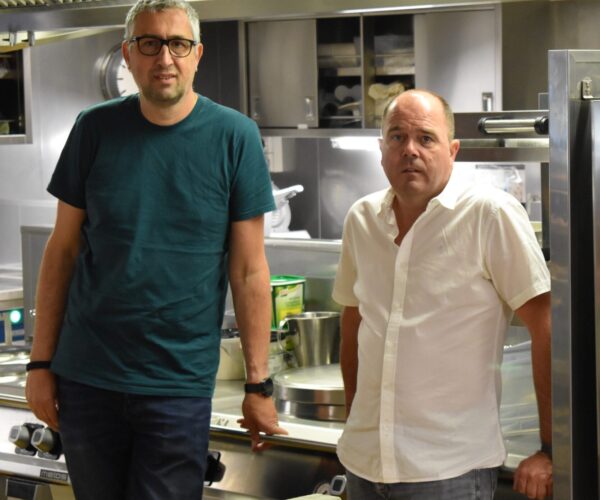 René Wouters (l) and Roland Moesman of Bouter Grootkeukens in the RSV Nuyina kitchen.
René Wouters (l) and Roland Moesman of Bouter Grootkeukens in the RSV Nuyina kitchen.
Bouter Grootkeukens is one of the top three most successful suppliers of industrial kitchens in the Netherlands. For about sixty years, the Zoetermeer-based company has supplied and installed professional kitchens in hotels, hospitals, educational institutions, company restaurants, holiday parks, theatres and petrol stations. Since 1995, Bouter has also supplied kitchens for (seagoing) ships. “It is a completely different way of working than when you build a kitchen for a restaurant,” says René Wouters. “First of all, you are dealing with different electrical voltages. That means that your equipment needs to be adapted.”
“On a ship you are working with 440 volts and 60 Hertz without neutral (blue wired) while on land it’s 400 volts and 50 Hertz with neutral. And, of course, you have to take into account that a ship tilts in the water. A normal boiler, for example, would stop working immediately. We have come up with all sorts of great ready-made solutions for situations like that. The hobs of the cookers in our ships’ kitchens have upright edges so that the pans cannot fall off, and all the tables are fitted with hand rails.”
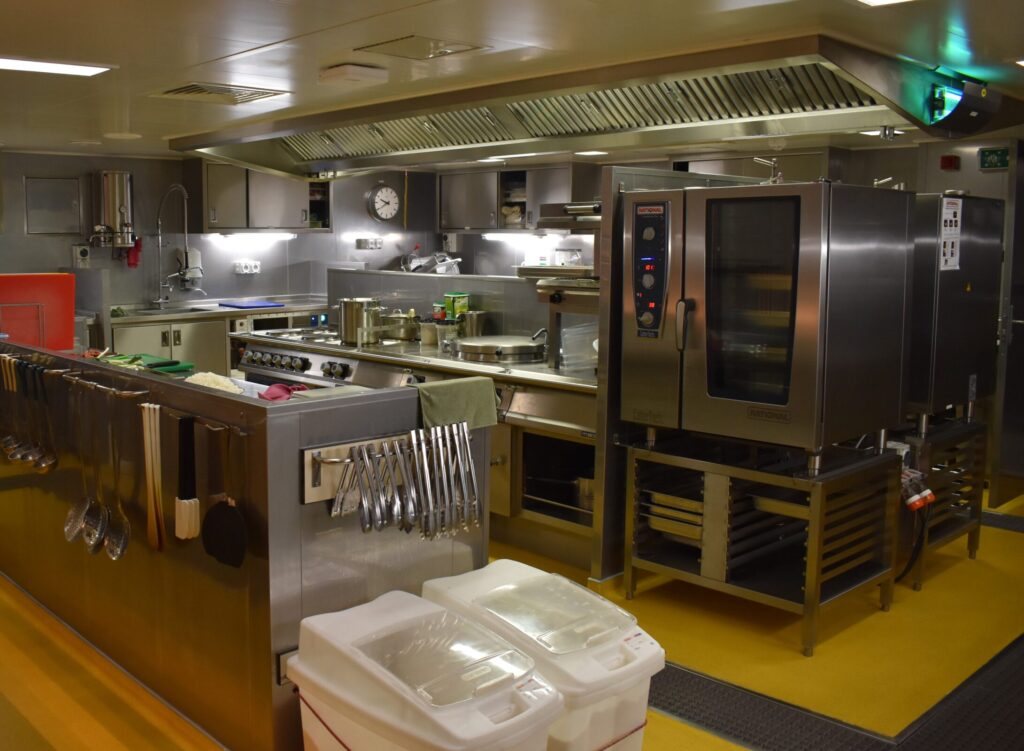 Installing the kitchen on Australian vessel Nuyina was an intensive job that took several months.
Installing the kitchen on Australian vessel Nuyina was an intensive job that took several months.
Roland Moesman continues: “When installing a seaworthy kitchen, you also have to take into account that, in terms of layout, a ship is totally different from, say, a hotel. On board, there are narrow corridors, narrow doors and passages, portholes, and steps everywhere…” The specialists from Bouter Grootkeukens installed the galley equipment (the kitchen itself), the mess hall, dishwashing room and laundry on the Antarctic Supply Research Vessel RSV Nuyina, and will do the same (this time including a bakery!) on board the new Combat Support Ship Den Helder.
Bouter also supplied the high-tech laboratory on RSV Nuyina. “Because the lab works with sea water, we used very high quality stainless steel,” says René. Nuyina’s kitchen was designed in close consultation with engineers and buyers from Damen Naval. The materials were produced in a factory in Kampen, the Netherlands. These were checked and accepted before being transported to Damen Shipyards Galati in Romania. They were brought on board after a few months of being in storage.
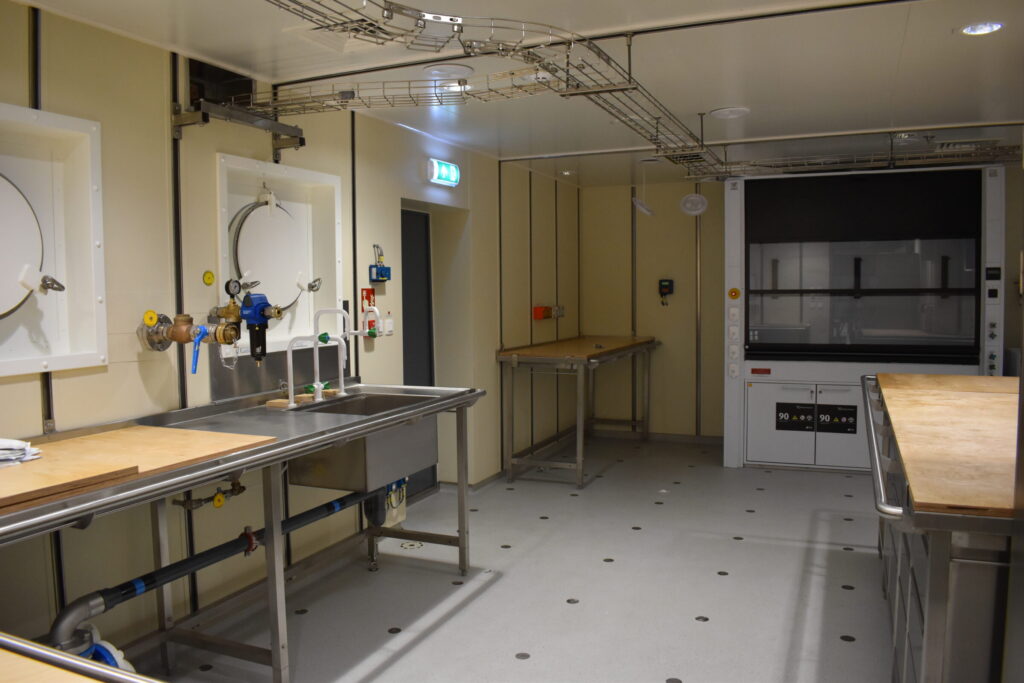 Bouter also supplied the high-tech laboratory on RSV Nuyina.
Bouter also supplied the high-tech laboratory on RSV Nuyina.
“All the pallets were stickered; the stickers allowed us to know exactly which pallets had to be taken on board the Nuyina at what time,” says René. Installing the kitchen on the Australian vessel was an intensive job that took several months and sometimes involved Bouter’s technicians working on the ship for three weeks at a time, say René and Roland.
“Building kitchens on a ship is a specialist skill. With everything you do, you have to take into account that a ship tilts in the water." René Wouters
Bouter Grootkeukens is part of the Sligro Food Group. “We are a financially healthy company and our aim is to grow so that we become the exclusive market leader in our sector in the Netherlands,” says Roland. “We are also a dynamic company. Every day is different and that makes the work enormously exciting.” A professional Bouter kitchen can vary in price from €5,000 to as much as €2.5 million. The company employs 125 people at its headquarters in Zoetermeer and at its service base in Assen. About half of them – some sixty people – are specifically engaged in client service and maintenance. Aftercare and service are important. “Selling a kitchen is one thing,” says René. “But if the buyer is going to use it, he needs to be sure that if a fault occurs, it will be sorted out quickly.”
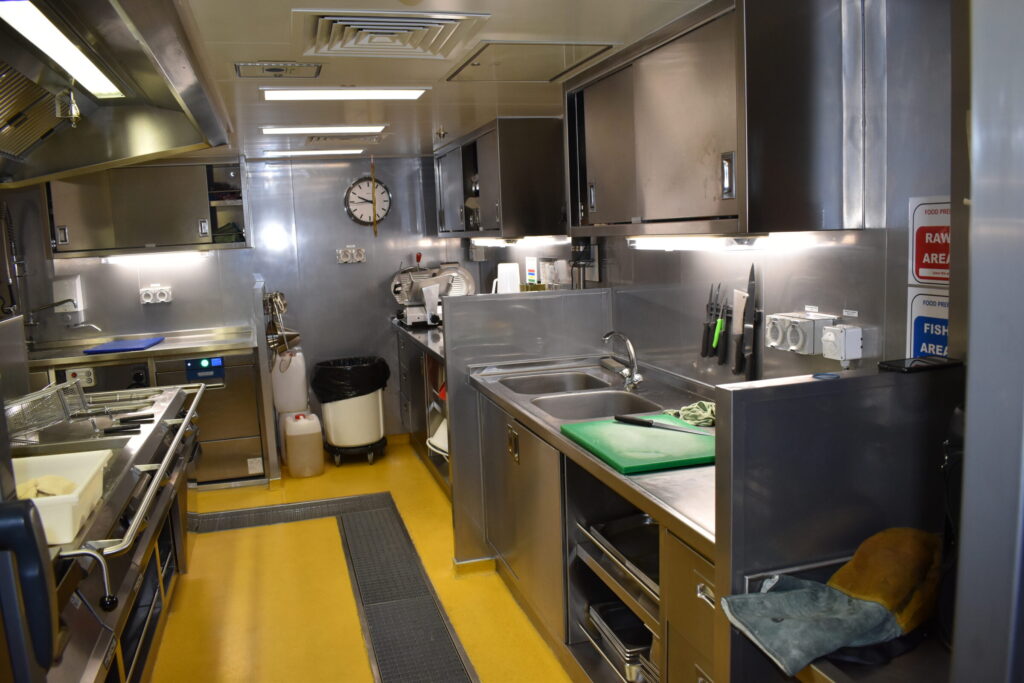 “When installing a seaworthy kitchen, you also have to take into account that, in terms of layout, a ship is totally different from, say, a hotel."
“When installing a seaworthy kitchen, you also have to take into account that, in terms of layout, a ship is totally different from, say, a hotel."
“Ovens always break down on a Friday evening or at the weekend when the restaurant is full, instead of on a Monday morning,” jokes Roland. René: “But for the most essential equipment and for equipment that is more sensitive to wear and tear, we give the customer a spare parts package. These parts are also listed on the so-called RSPL: Recommended Spare Parts List. In the unlikely event of something going wrong, especially on the high seas, we cannot always come and help straight away.”
Bouter Grootkeukens has been working for Damen Naval for about twenty years now. Because both parties know each other well by now, they know what they can expect from each other. This results in effective communication, say Roland and René. According to them, this applies to all levels: engineering, execution and general contact. They are happy with the collaboration: “Damen is a wonderful company with unique projects; it is without a doubt a first-rate name in the shipping world.”
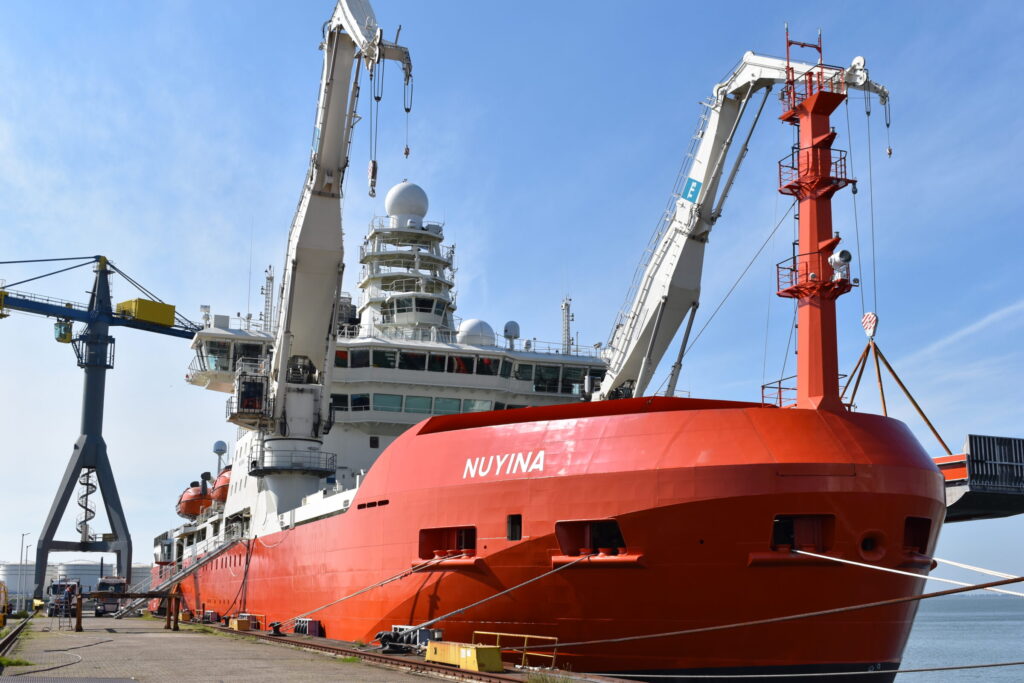 Antarctic Supply Research Vessel RSV Nuyina docked in Vlissingen-Oost.
Antarctic Supply Research Vessel RSV Nuyina docked in Vlissingen-Oost.

